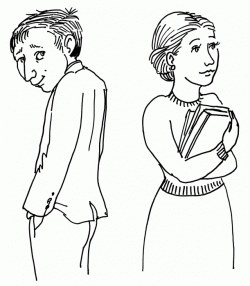Ditherer: Don't be a lover like J. Alfred
Q. Taken from the title character of T. S. Eliot's 1915 poem "The Love Song of J. Alfred Prufrock" comes the adjective "Prufrockian." What kind of lover is that? –J. Frost
A. One marked by timidity and indecisiveness and beset by unfulfilled aspirations, says Anu Garg in The Dord, The Diglot, and an Avocado or Two. The aging hero Prufrock is haunted by his cautious approach to life, lamenting "I have measured out my life with coffee spoons." He also wonders about all the possible romances he didn't dare broach: "Do I dare disturb the universe?"
Concludes Garg, "If only Prufrock had known Tennyson's lines written in 1850:
"'Tis better to have loved and lost
Than never to have loved at all."
Q. "Do I love you because you are beautiful, or are you beautiful because I love you?" wondered Prince Charming in Rodgers and Hammerstein's Cinderella. What psychological truth was he getting at? –P. Frosch
A. Just as familiarity breeds fondness and likeness begets liking, love tends to see loveliness, says David G. Myers in Social Psychology. Studies show that the more in love two people are, the less attractive they find the rest of the opposite sex.
"The grass may be greener on the other side, but happy gardeners are less likely to notice," add Rowland Miller and Jeffrey Simpson. Or as Myers puts it, to some extent beauty really is in the eye of the beholder.
A striking example of this was Henry James's description of novelist George Eliot (the pen name of Mary Ann Evans): "She is magnificently ugly—deliciously hideous. She has a low forehead, a dull grey eye, a vast pendulous nose, a huge mouth, full of uneven teeth, and a chin and jawbone qui n'en finissent pas....
“Now in this vast ugliness resides a most powerful beauty which, in a few brief minutes, steals forth and charms the mind, so that you end as I ended– in falling in love with her."
Q. Are you good at math? Then try to complete the last two in this sequence: 1=3, 2=3, 3=5, 4=4, 5=4, 6=3, 7=5, 8=5, 9=4, 10=3, 11=?, 12=? –A. E. Newman
A. Though the setup question implies a need for good math skills, the answer doesn't involve math so much as "thinking outside the box." Since the answer to each example is the number of letters in the written number ("one" = 3 letters, "three" = 5), then 11 = 6 and 12 = 6, because "eleven" and "twelve" both have 6 letters.
Q. What are a few of history's truly diabolical bugs? –S. Man
A. Members of Christopher Columbus's crew cut off their toes, so desperate were they to rid themselves of infestations of the chigoe flea, which burrows under toenails and lays eggs there, says Amy Stewart in Wicked Bugs. Typhus-infested body lice helped bring down Napoleon Bonaparte's army during its failed 1812 campaign against Russia; a century later, during the Russian Civil War, Vladimir Lenin declared, "Either socialism will defeat the louse, or the louse will defeat socialism."
Malaria, called our "forever enemy," comes from the Italian word for "bad air," mirroring the commonly held belief that malaria was simply present in the air. But some early medical texts referencing malarial fever suggested an insect bite could be the cause. We now know that mosquitoes are to blame, as they also are for dengue fever, yellow fever, Rift Valley fever, and about a hundred others. In fact, roughly one in five of all insect-transmitted diseases come from mosquitoes, making them the world's deadliest insect, Stewart says, adding, "Malaria is believed to have killed more people than all wars combined."
~
Send Strange questions to brothers Bill and Rich at [email protected]
